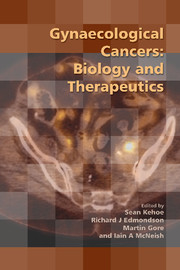Book contents
- Frontmatter
- Contents
- Participants
- Declarations of personal interest
- Preface
- SECTION 1 BIOLOGY OF GYNAECOLOGICAL CANCERS: OUR CURRENT UNDERSTANDING
- 1 Morphological sub-types of ovarian carcinoma: new developments and pathogenesis
- 2 Novel treatment strategies for targeting genetic changes in endometrial cancer
- 3 Epigenetic biomarkers in ovarian cancer
- 4 Predictive biology of ovarian cancer
- SECTION 2 THE TRANSLATION OF BIOLOGY TO THE CLINIC
- SECTION 3 IMAGING AND THERAPY: STATE OF THE ART
- SECTION 4 WHAT QUESTIONS ARE BEING ASKED BY CURRENT CLINICAL TRIALS?
- SECTION 5 CONSENSUS VIEWS
- Index
1 - Morphological sub-types of ovarian carcinoma: new developments and pathogenesis
from SECTION 1 - BIOLOGY OF GYNAECOLOGICAL CANCERS: OUR CURRENT UNDERSTANDING
Published online by Cambridge University Press: 05 February 2014
- Frontmatter
- Contents
- Participants
- Declarations of personal interest
- Preface
- SECTION 1 BIOLOGY OF GYNAECOLOGICAL CANCERS: OUR CURRENT UNDERSTANDING
- 1 Morphological sub-types of ovarian carcinoma: new developments and pathogenesis
- 2 Novel treatment strategies for targeting genetic changes in endometrial cancer
- 3 Epigenetic biomarkers in ovarian cancer
- 4 Predictive biology of ovarian cancer
- SECTION 2 THE TRANSLATION OF BIOLOGY TO THE CLINIC
- SECTION 3 IMAGING AND THERAPY: STATE OF THE ART
- SECTION 4 WHAT QUESTIONS ARE BEING ASKED BY CURRENT CLINICAL TRIALS?
- SECTION 5 CONSENSUS VIEWS
- Index
Summary
Introduction
In most developed countries, ovarian carcinoma is the second most common malignancy of the female genital tract, following endometrial carcinoma. Most cases present at an advanced stage and the overall prognosis is poor. Although clinically often considered as one disease, there is an increasing realisation that the various morphological sub-types of ovarian carcinoma are associated with distinct molecular alterations and have different natural history and prognosis. Most studies lump the various morphological sub-types of ovarian carcinoma together, with the result that it is difficult to tease out the behaviour of the various tumour sub-types; with our current state of knowledge, this is not appropriate. Given these factors, and the realisation that some tumour sub-types, for example clear cell, mucinous and low-grade serous, do not respond well to traditional ovarian chemotherapeutic agents and that continuing trials are investigating the efficacy of various agents in some of these tumour sub-types, it is clear that accurate pathological typing of ovarian carcinomas will be critical in the future in directing therapy. To this end, it is recommended that central pathology review becomes mandatory in ovarian carcinoma (and other gynaecological tumours) trials when treatment is dependent on the morphological sub-type or some other pathological parameter. In the UK, this should be organised by the British Association of Gynaecological Pathologists (BAGP) representative on the National Cancer Research Institute (NCRI) Gynaecological Cancer Clinical Studies Group.
In this review, I cover the major morphological sub-types of ovarian carcinoma, including their pathogenesis, and discuss problematic areas in typing.
Keywords
- Type
- Chapter
- Information
- Gynaecological CancersBiology and Therapeutics, pp. 3 - 16Publisher: Cambridge University PressPrint publication year: 2011
- 1
- Cited by



